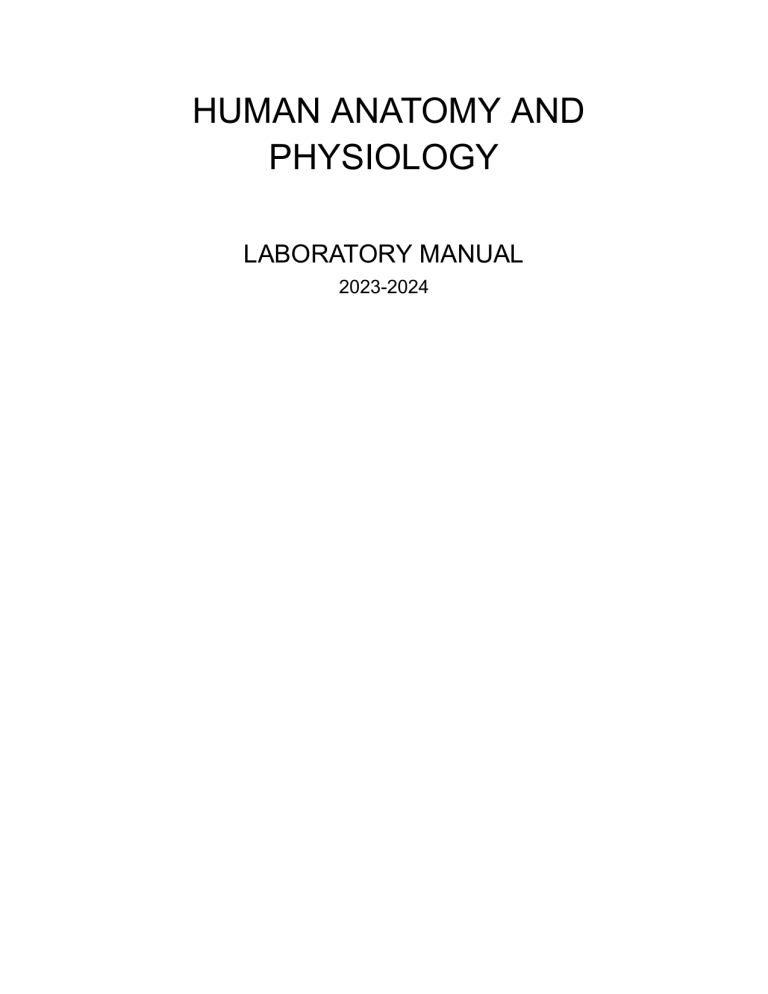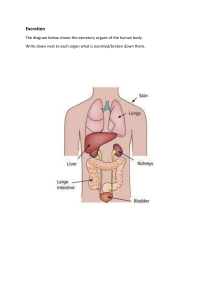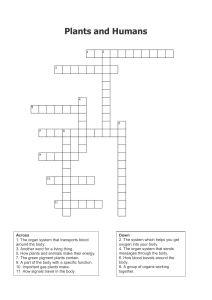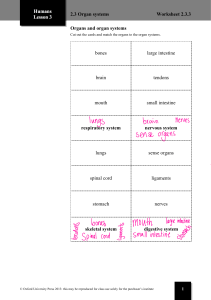
HUMAN ANATOMY AND PHYSIOLOGY LABORATORY MANUAL 2023-2024 ACTIVITY 1 HUMAN BODY AS A SYSTEM A system is defined as “an assemblage of objects united by some form of regular interaction of interdependence”. The system theory talks of the human body as a whole, the parts comprising the whole and the relationship existing among these parts and how our bodies are put together and how they work. PERSONAL OBJECTIVES: ● We should be able to identify the different functions of the different organ systems. ● We should be able to understand the structure of the organ system. GROUP OBJECTIVES: ● The group will be able to explain to the students on how to define each system as reliant on each other. ● We will be able to discuss the different functions of the organ system. ● We will be able to distinguish the parts and functions of the human body as a system. MATERIALS: Books (references) Pencil A. Complete the sentence by filling out the missing organ system described by each statement. 1. _______________- consists of bones, cartilages, ligaments, and joints. It supports the body and provides a framework that the skeletal muscle uses to cause movements. 2. _______________- is the external covering of the body. It protects the deeper tissues from injury and provides a barrier to pathogens and chemicals. 3. _______________- moves the skeleton and produces heat, its function is to contract or shorten. When this happens, movement occurs. 4. _______________- regulates body functions by means of impulse. It consists of the brain,spinal cord, nerves and sensory receptors. 5. _______________- regulates body functions by means of hormones. 6. _______________- transport oxygen and nutrients to the tissue. 7. _______________- keep the body constantly supplied with oxygen and to remove carbon dioxide. 8. _______________- destroys pathogens that enter the body. 9. _______________- breakdown food and deliver the products to the blood for dispersal to the body cells. 10. _______________- removes the nitrogen containing wastes from the blood and flushes them from the body in urine. 11. _______________- produce eggs or sperm to continue the human species. B. Match the organs with the corresponding system of the body. Write the letter of the correct answer on the space provided before each number. SYSTEM BODY ORGANS ____ 1. Respiratory a. Joints ____ 2. Reproductive b. Larynx ____ 3. Musculo-Skeletal c. Thyroid ____ 4. Cardiovascular d. Heart ____ 5. Nervous e. Kidneys ____ 6. Urinary f. Esophagus ____ 7. Digestive g. Spinal nerves ____ 8. Lymphatic h. Spleen ____ 9. Integumentary i. Uterus ____ 10. Endocrine j. Hair C. Below are the activities/events. Identify the system involved in each activity. Write the letter of the correct answer before each number. _______1. Coughing a. Cardiovascular _______2. Menstruating b. Digestive _______3. Voiding c. Musculo-Skeletal _______4. Defecating d. Integumentary _______5. Perspiring e. Urinary f. Reproductive g. Respiratory D. Complete the following: ❖ Identify the system in the given picture and provide its functions and organs involved. ❖ Draw the system given and provide its functions and organs involved. NAME OF THE SYSTEM ORGANS INVOLVED FUNCTION OF THE SYSTEM _______________________ Transports nutrients, waste products, gases, and hormones throughout the body; plays a role in the immune response and the regulation of body temperature. Consists of the heart, blood vessels, and blood. ______________________ Removes waste products from the blood and regulates blood pH, ion balance, and water balance. Consists of the kidneys, urinary bladder, and ureters ______________________ Exchanges oxygen and carbon dioxide between the blood and air and regulates blood pH. Consists of the lungs and respiratory passages Provides protection and support, allows body movements, produces blood cells, and stores minerals and adipose tissue. Consists of bones, associated cartilages, ligaments, and joints _______________________ Produces body movements, maintains posture, and produces body heat. Consists of muscles attached to the skeleton by tendons __________________________ Male Reproductive System Female Reproductive System _________________________ Produces and transfers sperm cells to the female and produces hormones that influence sexual functions and behaviors. Consists of the testes, accessory structures, ducts, and penis Produces oocytes and is the site of fertilization and fetal development; produces milk for the newborn; produces hormones that influence sexual function and behaviors. Consists of the ovaries, uterine tubes, uterus, vagina, mammary glands, and associated structures. Provides protection, regulates temperature, prevents water loss, and helps produce vitamin D. Consists of skin, hair, nails, sebaceous glands and sweat glands. _________________________ LYMPHATIC SYSTEM Removes foreign substances from the blood and lymph, combats disease, maintains tissue fluid balance, and absorbs dietary fats from the digestive tract. Consists of the lymphatic vessels, lymph nodes, and other Lymphatic organs. ENDOCRINE SYSTEM NERVOUS SYSTEM DIGESTIVE SYSTEM A major regulatory system that influences metabolism, growth, reproduction, and many other functions. Consists of endocrine glands, such as the pituitary, that secrete hormones A major regulatory system that detects sensations and controls movements, physiological processes, and intellectual functions. Consists of the brain, spinal cord, nerves, and sensory receptors. Performs the mechanical and chemical processes of digestion, absorption of nutrients, and elimination of wastes. Consists of the mouth, esophagus, stomach, intestines, and accessory organs CONCLUSION: ____________________________________________________________________________ ____________________________________________________________________________ ____________________________________________________________________________ ____________________________________________________________________________ ____________________________________________________________________________ ____________________________________________________________________________ ____________________________________________________________________________ ____________________________________________________________________________ ____________________________________________________________________________ ____________________________________________________________________________ ACTIVITY 2 BODY REGIONS AND ORGANS The study of body parts, structures and their relationship with each other is Anatomy. The study of the function of each body part is Physiology. Anatomy and Physiology are interdependent and, in many cases, It is the function that determines the structure. The gross external appearance of the body can be described in various ways. These include PLANES of the body and REGIONS of the body. The internal body organization is described by body cavities and systems. OBJECTIVES: ❖ The students will be able to: ➢ Describe the possible sections through the body or an organ. ➢ Identify the different planes that pass through the body. ➢ Use appropriate anatomical terminology to identify key body structures, body regions, and direction in the body. ➢ Demonstrate the anatomical position. ➢ Identify three planes most commonly used in the study of anatomy. MATERIALS: Books (references) A. Define each term and provide the term with the opposite meaning. 1. Inferior ______________________________________________________________________ ______________________________________________________________________ Opposite ______________________________________________________________________ ______________________________________________________________________ 2. Proximal ______________________________________________________________________ ______________________________________________________________________ Opposite ______________________________________________________________________ ______________________________________________________________________ 3. Lateral ______________________________________________________________________ ______________________________________________________________________ Opposite ______________________________________________________________________ ______________________________________________________________________ 4. Peripheral ______________________________________________________________________ ______________________________________________________________________ Opposite ______________________________________________________________________ ______________________________________________________________________ 5. Superficial ______________________________________________________________________ ______________________________________________________________________ Opposite ______________________________________________________________________ ______________________________________________________________________ 6. Anterior ______________________________________________________________________ ______________________________________________________________________ Opposite ______________________________________________________________________ ______________________________________________________________________ 7. Dorsal ______________________________________________________________________ ______________________________________________________________________ Opposite ______________________________________________________________________ ______________________________________________________________________ 8. Internal ______________________________________________________________________ ______________________________________________________________________ Opposite ______________________________________________________________________ ______________________________________________________________________ B. Explain how the body or an organ is divided into the following planes. 1. Sagittal plane plane runs vertically through the body and separates it into RIGHT and LEFT parts 2. Mid-sagittal Plane - is a sagittal plane that passes through the midline of the body, dividing it into EQUAL right and left halves 3. Horizontal or Transverse Plane - transverse (trans-vers) plane, or horizontal plane, runs parallel to the surface of the ground, dividing the body into superior(ABOVE) and inferior parts(LOWER) 4. Frontal or Coronal Plane - runs vertically from right to left and divides the body into anterior and posterior parts. FRONT &BACK A cut along the length of the organ is a LONGITUDINAL SECTION TRANSVERE SECTION, or cross section, cuts completely through an organ If a cut is made diagonally across the long axis, it is called an OBLIQUE SECTION. C. Label the following drawing. D. Complete the table. Write at most two(2) organs in each cavity. CAVITY ORGANS 1. Dorsal 2. Cranial 3. Vertebral 4. Orbital 5. Thoracic 6. Abdominal 7. Oral E. Supply the missing words/phrases. Write your answer on the blanks provided. 1. The chest is __________ to the abdomen and ________ to the neck. 2. The ______ surface of the nose is covered with the skin while ______ the surface is covered with mucus membrane. 3. The little finger is on the ______ side of the hand and the thumb is on the ______ side. 4. The patella is on the ______ or ______ aspect of the lower extremity. 5. The elbow is on the ________ aspect of the upper extremities. 6. A line running through the middle of the forehead, tip of the nose and umbilicus would be in a _________ plane. 7. A ___________ would divide the body into the front back portion. 8. If you put your hand flat on the desk, the ________surface will be touching it. 9. The urinary bladder is located in the _________ area of the abdomen. 10. The uterus is found in the _______ cavity. CONCLUSION: ____________________________________________________________________________ ____________________________________________________________________________ ____________________________________________________________________________ ____________________________________________________________________________ ____________________________________________________________________________




